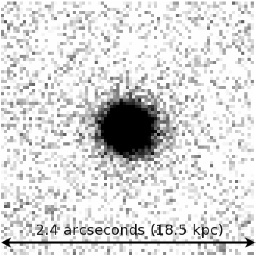Star Formation from DLA Gas in the
Outskirts of Lyman Break Galaxies at z~3

Star Formation from DLA Gas in the
Outskirts of Lyman Break Galaxies at z~3
We present evidence for spatially extended low surface brightness emission around Lyman break galaxies (LBGs) in the V-band image of the Hubble Ultra Deep Field, corresponding to the z~3 rest-frame FUV light, which is a sensitive measure of Star Formation Rates (SFRs). We find that the covering fraction of molecular gas at z~3 is not adequate to explain the emission in the outskirts of LBGs, while the covering fraction of neutral atomic-dominated hydrogen gas at high redshift is sufficient. We develop a theoretical framework to connect this emission around LBGs to the expected emission from neutral H I gas i.e., Damped Lyα systems (DLAs), using the Kennicutt-Schmidt (KS) relation. Working under the hypothesis that the observed FUV emission in the outskirts of LBGs is from in situ star formation in atomic-dominated hydrogen gas, the results suggest that the SFR efficiency in such gas at z~3 is between factors of 10 and 50 lower than predictions based on the local KS relation. The total star formation rate density in atomic-dominated gas at z~3 is constrained to be ~10% of that observed from the inner regions of LBGs. In addition, the metals produced by in in situ star formation in the outskirts of LBGs yield metallicities comparable to those of DLAs, which is a possible solution to the ‘Missing Metals’ problem for DLAs. Finally, the atomic-dominated gas in the outskirts of galaxies at both high and low redshift have similar reduced SFR efficiencies and are consistent with the same power law.
Graduate Ph.D. work from at the University of California, San Diego with Prof. Arthur Wolfe.




